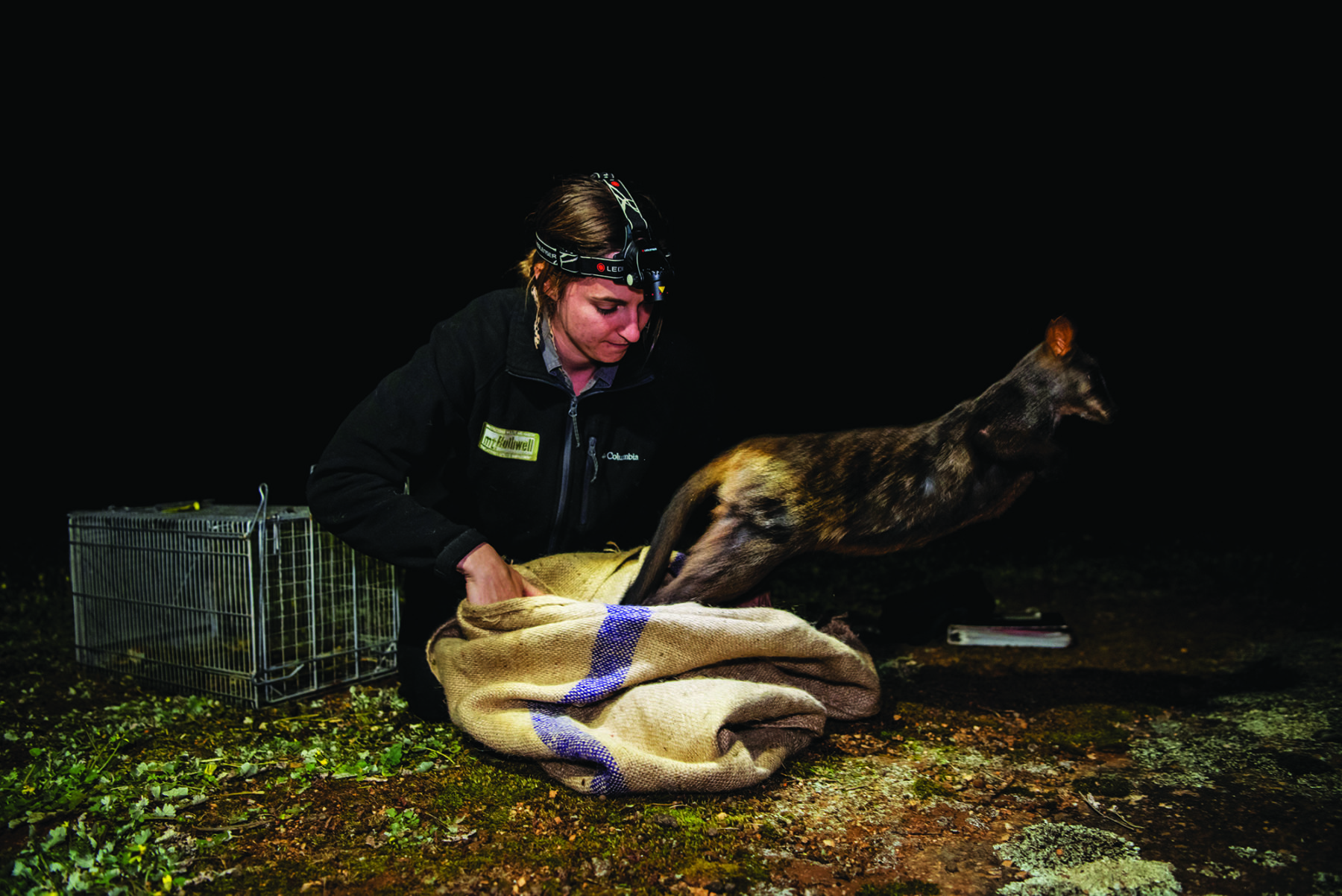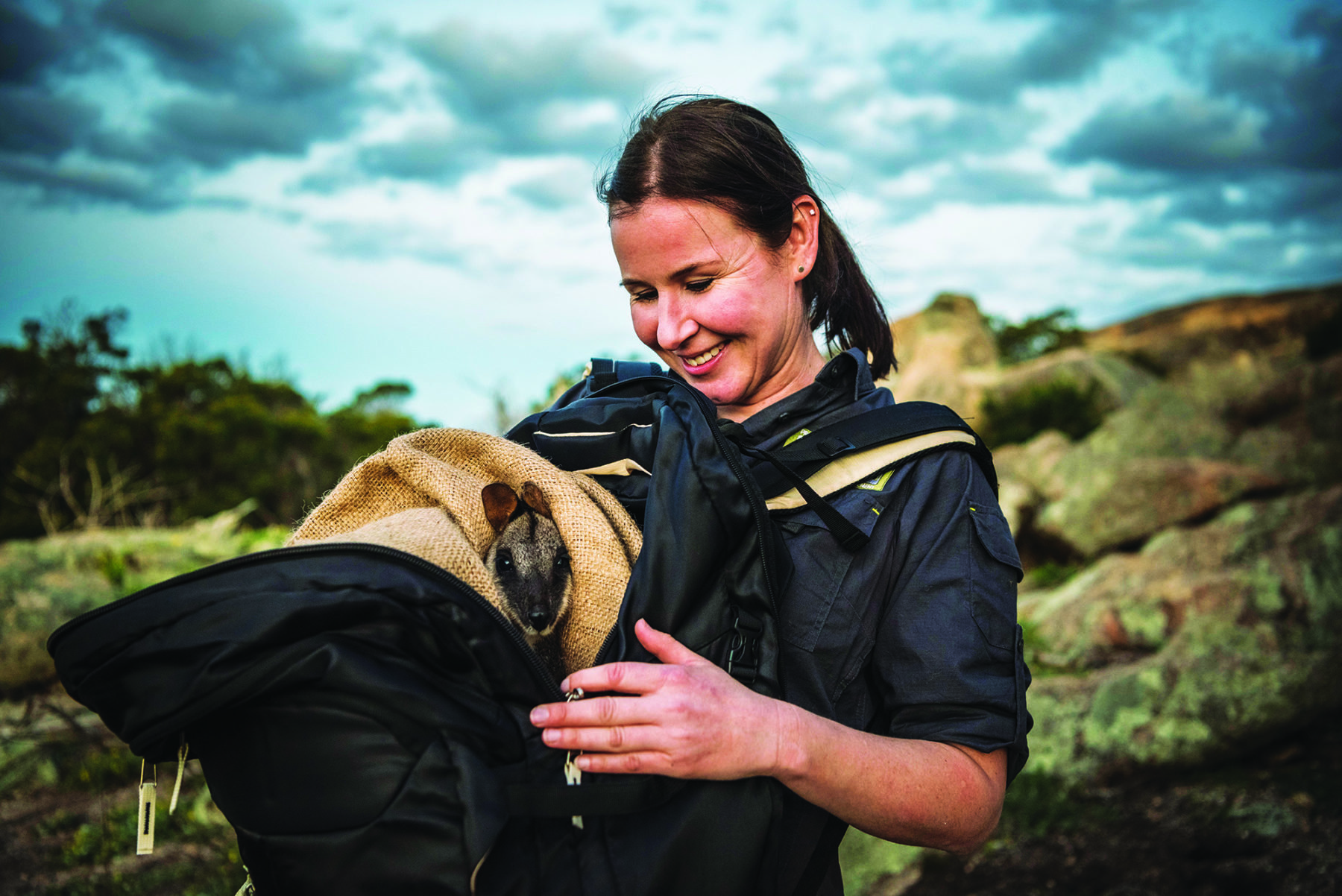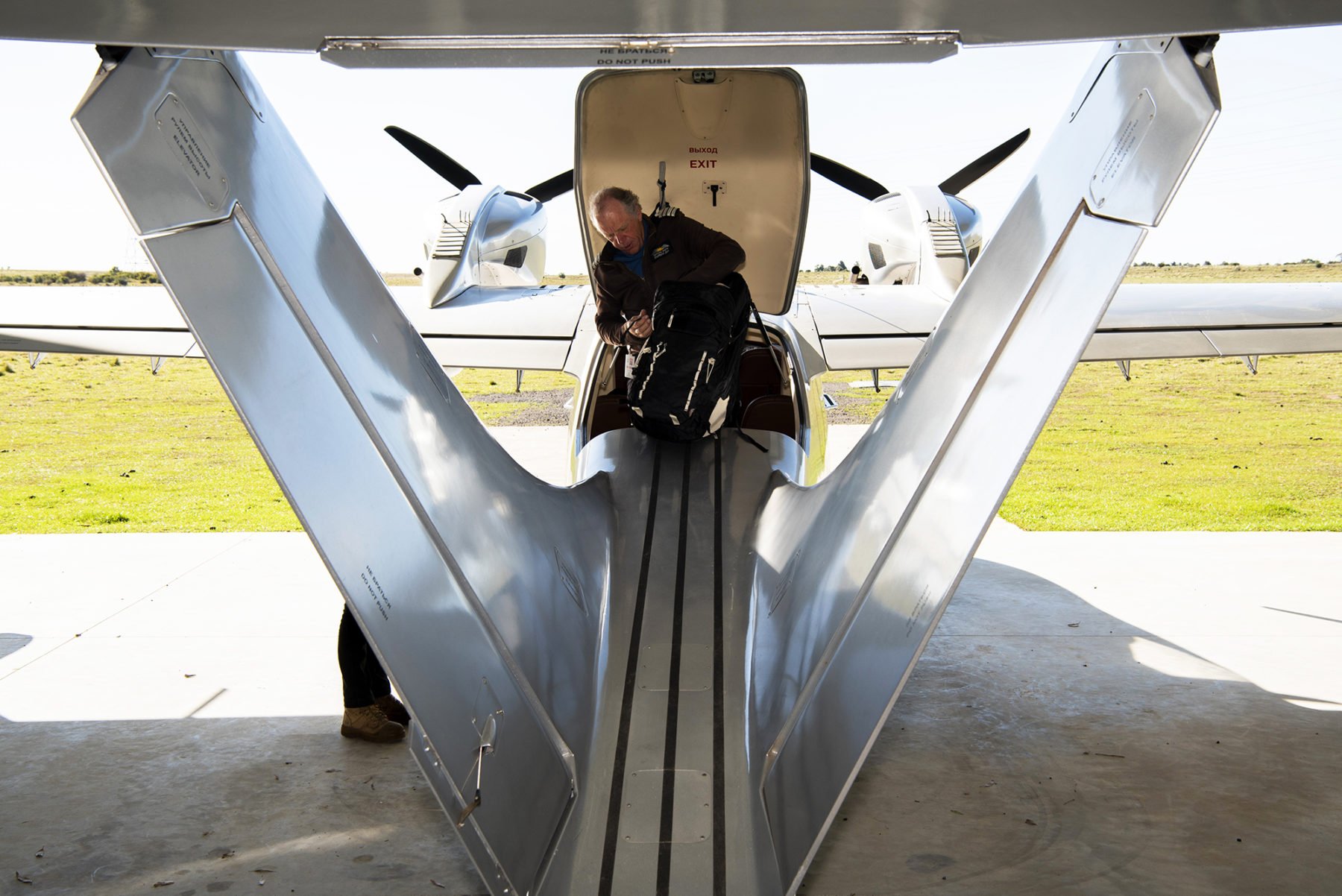THE HEALTHY, NOT QUITE fully grown, female southern brush-tailed rock-wallaby is unusually calm in the heavy hessian sack resting on the lap of Annette Rypalski, biodiversity director at the Mt Rothwell Biodiversity Interpretation Centre.
This extremely rare wallaby has just been transferred into the sack after being coaxed from a safe trap she entered while foraging. She’s lived at the centre, located at Mount Rothwell near Geelong in Victoria, since being rescued from her usual home at Tidbinbilla Nature Reserve, in the Australian Capital Territory, which was threatened during the Black Summer fires of 2019–20.
Annette unfurls the sack, revealing attractive ears and a black face with white cheek stripes. Nicknamed ‘The Shadow’ for its habit of hiding in rugged rocky habitat, this wallaby is among Australia’s rarest mammals, one of three genetically distinct groups of rock-wallaby. Only 40 of her group survive in the wild, in one lonely East Gippsland location. Another five or six remain from a reintroduction program in the Grampians National Park.

Today, this animal is one of a pair being returned to Tidbinbilla, on the edge of Namadgi National Park, where a team of carers is waiting to greet them. They’re the last of 17 wallabies evacuated in February last year in extraordinary circumstances – airlifted to safety on an Australian Defence Force Hercules aircraft from the Orroral Valley as fire blazed frighteningly close.
Now, after months of jigsaw-puzzle planning, Annette will soon complete a huge logistical feat – the safe return of all the rescued wallabies. I’m here to see the start of their homeward journey.
“Seven months!” she says, laughing with relief. “Seven months to catch 17 wallabies – lots of trapping, lots of late nights, lots of barbecues! It will certainly be a weight lifted off our shoulders.” Annette, two wildlife officers and about 20 volunteers have been caring for wallabies from the southern group at the centre since 2015, when 20 were introduced here as part of a breeding program by the species’ recovery team. Under the care of Annette and her team and the watchful eye of geneticists and scientists, the population swelled to 80.
“There’s another one,” Annette says, pointing to a wallaby in the rocks, its characteristically long tail trailing behind. Then she safely stows the sack with the rescued animal into a large backpack “just like a pouch” that she hoists gently onto her back. Later, the pair will be carefully strapped to the backs of seats in a small, private plane that will carry them back to their home. Eagerly waiting to meet that flight will be Dr Jennifer Pierson, senior wildlife officer at Tidbinbilla.
“This was a huge operation,” Jennifer agrees. “There will be such a huge sense of relief and happiness to be able to get back to our work of breeding them. We had great luck that they handled the evacuation so well and that they’re all in good health.”
The repatriation of these final members of the Tidbinbilla colony will herald a return to the recovery team’s long-term goals: to secure the future of this critically endangered wallaby. “The main goal for the recovery program right now is to have two large, free-range sites of genetically robust breeding animals as a source population for future translocations,” Jennifer says. The Tidbinbilla colony was the crucial second site, which was one reason tensions were so high when the wallabies first arrived at Mt Rothwell in February last year.
“I didn’t think they would make it,” Annette admits. “They’d taken in a lot of smoke where they were. They’d been in boxes for so long. The conditions were horrible. It was hot. They were wet. The transfers would have been quite stressful.”
The wallabies were not alone in their stress. With the fire approaching Tidbinbilla, staff at both ends of the Hercules flight were tense after planning an evacuation for weeks, as millions of hectares burned across Australia’s east coast. Mt Rothwell had been put on alert three weeks earlier when staff at another ACT wildlife sanctuary under threat of fire – Mulligans Flat – had called, asking “Will you be prepared, potentially, to receive up to 300 animals if we have to evacuate?”
The Mulligans Flat evacuation never eventuated, but Mt Rothwell was by then in emergency mode and in preparation to receive two species of endangered animals from Tidbinbilla, eastern bettongs and the southern brush-tailed rock-wallabies. “They were pretty much counting the days down until the fire hit,” Annette says. “I was getting quite tense.”
It wasn’t just the Tidbinbilla population Annette was concerned about. The home of the only remaining wild colony, in East Gippsland, was also burning. It meant the population under Annette’s care at Mt Rothwell was the only one not under imminent threat of fire. But with temperatures just shy of 50ºC and huge swathes of the east coast burning, Annette wasn’t taking anything for granted.
“I remember thinking if Mt Rothwell catches fire we could lose this wallaby off the face of the planet,” she says. Fortunately, only 20 per cent of Tidbinbilla ultimately burnt.
Mt Rothwell’s population was the first “insurance population” and the animals evacuated from Tidbinbilla last February were intended to be the founders of the second. Getting them all home safely will mean this plan can be put into action.

Complex logistical challenge
The Tidbinbilla Project is not only about increasing the total population size: it’s also about ensuring the genetic quality of these animals. As for many species, when numbers decline, so can its gene pool, leaving it less resilient to threats and almost “functionally extinct”, unable to reproduce enough to ensure its survival.
“The individuals brought down from Tidbinbilla had unique genetics that were important for our breeding program to give the species the best chance of recovery,” says Dr Andrew Weeks, a University of Melbourne evolutionary geneticist and part of the Threatened Species Recovery Team. “Because the southern population has been small for a long, long time, it’s lost a lot of genetic variation. That’s its biggest problem right now. Our program aims to address this issue directly.”
The Tidbinbilla and Mt Rothwell colonies have been carefully bred to ensure long-term survival, including the introduction of genes from the central group of animals found in south-eastern New South Wales
“The centrals are a lot healthier, genetically,” Andrew explains. “So we want some of their good genes, their healthy genes, in our southern population to give them a better chance for the future.”
The intricate nature of the breeding program created an equally complex logistical challenge when it came to evacuating and housing the animals at Mt Rothwell.
“It was 11pm and I was on the phone to the recovery team – to Andrew Weeks and the convenor – trying to figure out which wallabies to put where,” Annette says. “We had to look at the genetics of the animals and figure out which were the most valuable, which ones they would save first at Tidbinbilla and where they would go when they got here.”
As “Victoria’s largest feral predator-free ecosystem”, Mt Rothwell was a natural fit to receive the animals, with 473ha of predator-proof fencing protecting habitat in six pens ranging in size from 2ha to 250ha. The reserve, founded in 2000 as Little River Earth Sanctuary, was one of Australia’s early fenced conservation reserves. It was purchased privately by Nigel Sharp in 2006, and in 2017 Nigel’s newly formed not-for-profit Odonata took over.
The multiple pens central to the breeding programs at Mt Rothwell allowed Annette and her team to separate particular individuals from the Tidbinbilla colony and keep the carefully engineered social groups intact. “We had to figure out which pairs needed to be together, and where to house them,” Annette says. “We had bachelor groups, mothers with pouch-young and single males.”
If the evacuation was complicated, the following seven months were equally so for the Tidbinbilla team. The challenges of flying 17 wallabies home were many but most important was ensuring that Tidbinbilla’s 5450ha, to where they were being returned, was predator-free.
Like Mt Rothwell, Tidbinbilla is bordered by a predator fence, giving staff a dilemma on the evacuation day – leave gates open to allow remaining native animals to flee the fire, or keep them closed, to keep out foxes and other feral animals so the native animals could more easily be returned after the fire? The decision was made to open them – the lesser of two evils – but it meant months of feral animal management and monitoring to ensure a predator-free environment for the native animals’ return.
Another obstacle for the eventual return of the rescued wallabies was teaching them to trust traps, so the animals could be trapped quickly when it was time for them to go home. This included months of “free-feeding”, enticing them into traps using lucerne (“like chocolate for wallabies”) with doors locked open.
At Mt Rothwell, Annette and one of her team cradle the backpacks for the short drive to the hangar. The waiting plane, a silver four-seater flying boat, is owned and piloted for free by Mt Rothwell’s neighbour, Michael Smith, AGS 2016 Adventurer of the Year. He’s done the solo flight twice before, last time with four wallabies, so he knows he’ll spend the next two hours wishing they’d move inside the backpacks, just enough for him to know they’re okay.
With propellers spinning, Michael fills a water bottle for the flight ahead. At Tidbinbilla, a wildlife veterinarian is preparing for the routine inspection of the returning wallabies – a quick visual check for signs of stress. Once the animals have settled in, they’ll have full health reviews under general anaesthetic, to check for weight loss, abrasions, teeth issues and, for the female, pouch condition and other signs of breeding readiness. They’ll then go into a 60-day biosecurity quarantine before finally moving to free-range sites. But all of that is out of Annette’s hands now. Soon the wallabies will poke their heads out of the hessian sacks and bound with an almighty leap into the familiar surrounds of Tidbinbilla Nature Reserve.

Back at Mt Rothwell, Annette breathes a sigh of relief at the news of the wallabies’ safe departure. The two staff who’ve worked with her on the seven-month journey to send the animals home are jubilant. “We’re done!” they say, laughing. “Our job here is done.” But of course their long-term job is far from over. Also requiring attention at Mt Rothwell are eastern barred bandicoots, newly born eastern quolls and rufous bettongs that need moving between enclosures. Odonata has a growing endangered species program at Mt Rothwell and the work is ongoing.
As the drone of the propellers fades and the silver glint of wings disappears, Annette answers the question “How do you feel?” with unfettered honesty. “A little bit proud and a little bit angry,” she says. “I’m proud we pulled this one off so efficiently and effectively. I’m proud of my team – they were brilliant. But also, I’m angry. I’m angry that no-one really cares about the environment enough until something bad happens.
“It was sad to see so much of the country on fire. Billions of animals were burnt – and two of the last three populations of this wallaby could very nearly have been among them. We were the last ones standing, really. We were so vulnerable. It really scares me how close they came to extinction.”
As Mt Rothwell’s energetic on-ground leader, Annette carries a lot on her shoulders. But she also carries optimism about what can be done to change the future of the threatened species under her care. “Ultimately I want to put myself out of a job,” she says. “I want to take so many animals off the endangered list that I struggle to find any animals to save out there. That’s my goal.”



